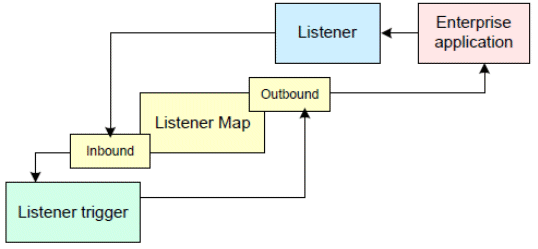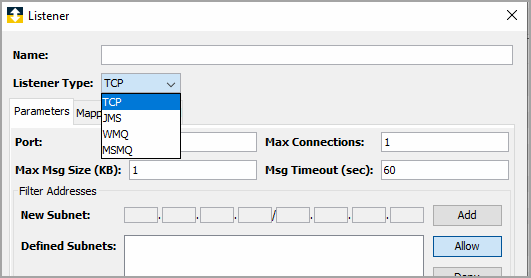A Listener defines the connectivity details and
features, such as mapping logs, when a message (or request)
is received from an enterprise application. The received
message is processed by a trigger.
Listeners are defined to represent message and queuing
applications, and TCP applications.
A listener component is comprised of a listener, listener map, and a listener trigger.

A listener can be configured to accept command requests
from a remote enterprise application. The content of the
request is mapped to an internal request using the listener
map. When a value request is received, the request will
cause the listener trigger to execute a sequence of actions
that were configured in the trigger definition.
Listener types
Command requests can be sent to the node using the following interface points as shown:

- A WebSphere MQ queue (for a WMQ listener types).
- A WebSphere SIB queue (for a JMS listener types). The listener is either a JMS WebSphere SIB listener or a JMS WebSphere SIB direct listener).
- A Microsoft Message Queuing queue (for MSMQ listener types).
- A TCP application (for TCP listener types).
A listener that is configured to interact with WebSphere MQ is referred to as a WMQ listener. You configure WMQ listeners to read requests messages on a remote WebSphere queue. The following sections will describe a WebSphere MQ listener. The concepts can also be applied to a WebSphere SIB integration point.
To summarize, the listener map works in combination with the listener and a special listener trigger. The listener trigger references the listener map. This allows an external enterprise application to execute a sequence of actions defined in the listener trigger that could effect changes on the node or on controller device variables.
A Listener can be optionally configured to send a response to every request it receives. The default message content format is XML.
The following illustrates how a WMQ listener works in conjunction with an enterprise application and the controller.

The WMQ listener supports an enterprise application initiated request to the node such as start or stop a project, start or stop a trigger, write to or read from a controller variable using the action list configured in the listener trigger definition.
The enterprise application submits the request via a queue that the WMQ listener is monitoring. Upon completion of the enterprise application request, the listener sends the results in a response message that is put on a remote reply queue. This is a bidirectional operation. For more information, see the Get Message From Controlled Listener action.
Controlled and non-controlled listeners
Non-controlled listener
A non-controlled listener is always waiting for the next command request from the remote queue provided the following process has taken place:
- A listener map definition has been created.
- A listener trigger has been created that references that listener map definition as the triggering event condition.
- The listener trigger and its associated project has been started.
Having received a request, the non-controlled listener will complete the processing and send a response (if configured to do so) before getting the next command request. The interval of time that the non-controlled listener waits before getting the next command is determined by how long the previous request takes to complete.
Controlled listener
A controlled listener, on the other hand, is configured so that a Get Message From Controlled Listener trigger action determines when the listener should get the command request from the remote queue. The result of getting a request from the queue is communicated to the action step. The point in time at which the Get Message From Controlled Listener action is executed is determined by the event condition associated with the trigger definition. The event condition could be on a certain schedule (schedule trigger) or associated with a controller variable change (data trigger). Note this trigger is not the listener trigger.
For more information, click Creating a controlled listener.
What's Inside